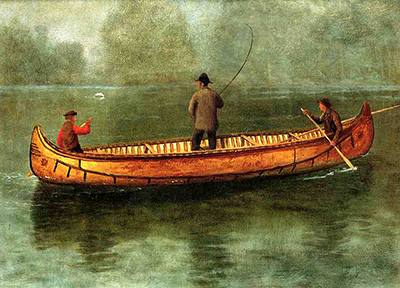In the canon of Albert Bierstadt's works, Fishing in a Canoe stands out as an atypical, but charming piece.
Bierstadt's reputation rests on his large-scale Luminist evocations of the American landscape, with diffuse floods of light and grandiose scenery. These large canvases are what we've come to associate with Albert Bierstadt, and provide an interesting context in which to place this very different painting. Fishing from a Canoe is a more intimate work. The painting depicts a fishing trip, and is distinct from more typical Bierstadt paintings in its smaller scale. Compared to a vast sweeping canvas such as Among the Sierra Nevada Mountains California this is small-scale, both in size and in subject.
Rather than a grand vista we have a fishing trip, three men in a canoe, one at each end rowing and one stood upright in the middle, the arc of his rod and the tautness of his line suggesting that the fish are biting. Bierstadt was known for his use of light, but the tones here are more muted. There is less sky than one would normally expect in a Bierstadt painting, and the eye is drawn to the focal point of the painting, the act of fishing. It's a personal affair, the oarsmen are clearly involved in the action, with one looking directly at where the fish will soon be breaking the water, it is the moment before the catch.
The impressionistic strokes of the background woods recall JMW Turner, and are unlike the lavish use of light in his paintings of Swiss and American landscapes. This fishing trip is a quieter business, conducted in a a peaceful manner. The bosky tones of the woodlands are mirrored in the limpid play of light on the water's surface. The figures are simply treated, with none of the hyper-realism of some Luminist painting, this adds to the sense of calm which pervades this painting, the counterpoint to the focal point of action, the simple act of catching a fish.




